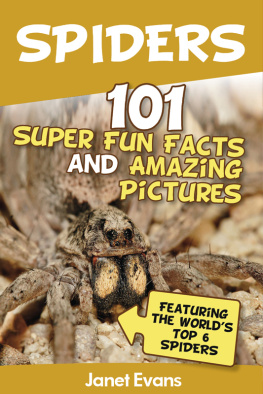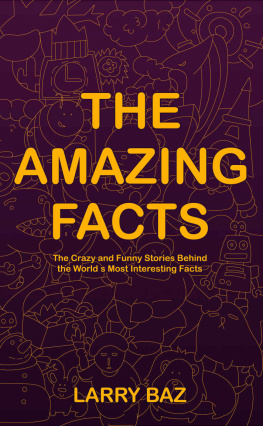Table of Contents
SPIDERS
Amazing Pictures & Fun Facts on Animals in Nature
Our Amazing World Series
Kay de Silva
Copyright Notice
Spiders - Our Amazing World Series
Copyright 2012 by Kay de Silva - All rights reserved
Please respect the author's copyright of this work. You may use this e-book for your personal enjoyment. Like a printed book you may share it with family and friends. In so doing please do not change the format or modify the content in any way. In addition, your license to enjoy this work does not extend to re-selling, using or re-distributing this work wholly or partially for any other commercial endeavour. In all other respects, as a licensed owner of this e-book you are invited to enjoy and benefit from this work. Please support the author, by spreading the word about this work to those who could benefit by it and encouraging them to obtain a personal license to enjoy the book.
Image Credits: Royalty Free images reproduced under licence from various stock image repositories. Images produced under a creative commons licences are duly attributed.
Books in the Our Amazing World Series
Marine Life Four-Pack
Dinosaurs
Tigers
Sharks
Snakes
Spiders
Bears
Horses
Dolphins
Sea Turtles
Whales
Penguins
Marsupials
Spiders

Spiders belong to a group of animals called arthropods. Arthropods include arachnids, insects , and crustaceans (shrimp, crabs, lobsters, and barnacles). Spiders are not insects. Like ticks, mites, and scorpions, spiders are arachnids.
There are over 40,000 species of spiders found all over the world. They have been around for over 300 million years.
Anatomy

Like all arthropods, spiders do not have skeletons or bones. Instead they have exoskeletons. This is a hard outer shell that covers and protects their bodies.
Arthropods also have segmented bodies and jointed legs. Spiders bodies are made up of two segments or parts. The front part is called the cephalothorax. Their eyes, fangs, stomach, and brain are found here. Their legs are attached to this segment.
All spiders have eight legs and claws at the end of their legs. Each leg has six joints. So you could say that spiders have 48 knees!
The second part of spiders bodies is their abdomen. The abdomen contains the heart, lungs, and digestive tract. It has six spinnerets or silk-producing glands that are located at the back end of the abdomen.
Habitat

Spiders are found anywhere insects can be found. This is because insects are spiders favorite food. Spiders live all over the world, except in Antarctica.
Spiders also live in all sorts of places. Some live in trees and plants. Others prefer caves, rocks, and deserts. Spiders can even be found on the seashore. If you look carefully, you will find that they share your home, too.
Senses

Most spiders have four pairs of eyes, but they have poor sight. They are mostly nearsighted, so they cannot see very far. The arrangement of spiders eyes varies according to their type or species. What they can see depends on this arrangement.
Spiders are able to move their sets of eyes in different directions. This lets them scan what is going on around them. Unlike humans, who can tell which way is up even when our eyes are shut, spiders cannot. They rely on their sight for balance.
Spiders use their sense of touch to feel their surroundings and to detect movement and vibrations. They rely on these vibrations to alert them to danger or to be aware of food or prey that may be trapped in their webs. Spiders are hairy. These hairs are connected to nerves that give them information.
Spiders also have a strong sense of smell. Male spiders use this sense to help them find mates. Spiders also emit scents to mark their territory.
Spider Silk

Spiders squeeze a liquid from their spinnerets to make silk. This liquid is a protein that is thicker than water. The liquid hardens as it makes contact with the air.
Spiders can make sticky and dry silk. Spider silk is 30 times thinner than a human hair and very light, but do not let this fool you. It is the strongest fiber found in nature.
If you compare the same weight of spider silk and steel, silk is five times stronger. Spider Silk is also elastic, so it breaks only when stretched to two to four times its length.
Spider silk is used to weave webs, line nests, make egg sacs, and wrap captured prey. Spiders also use their silk to help them travel. This is called ballooning. To do this they fasten one end of a silk thread, called a dragline , to a sturdy place. Then they launch themselves into the air, letting the wind carry them to their destination, just like Spiderman!
Spider Webs

Spiders are born to spin; they do not need to be taught. A spider's web is its home. Some spiders use a web to catch their prey, while others prefer to hunt.
Spiders weave three types of webs. Orb-webs are the most common type. These are shaped like bicycle wheels. They can be very detailed and fancy. Spiders sit close to the center of the web lying in wait for their prey, which these sticky webs help them trap.
The sheet-web is the second type of web. Spiders weave a sticky web horizontally, like a sheet. They also weave non-sticky lines above it. These lines help knock its prey down, onto the sticky sheet below.
The third type of web is called the funnel-web. This web is wide at the top and tapers down gradually, just like a funnel. Spiders lie in wait for their prey, hiding at the bottom of the web.
Spiders eat their webs when they are no longer useful, so they are recycled to make new webs. Webs in use are correctly called spider webs. Abandoned webs are called cobwebs.
Venom

Not all spiders have venom, but all spiders have fangs. Venomous spiders bite to catch prey when they are hungry. These spiders use their venom to paralyze their victims.
Other spiders poisons are strong enough to kill their prey. The venom of some types or species of spiders such as the Sydney Funnel Web and the Brazilian Wandering Spider is the most dangerous to humans.
Hunting

Spiders are carnivores , or meat eaters. Smaller spiders usually eat insects, but some of the larger ones also eat mice, bats, lizards, and small birds. Spiders are also cannibals, so they sometimes eat their own kind.
Only some spiders use webs to snare insects. Many spiders hunt their prey. Others sit camouflaged on plants or build burrows with trap doors and pounce on unsuspecting prey.












